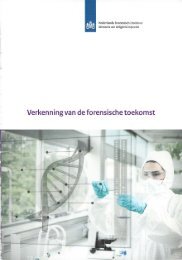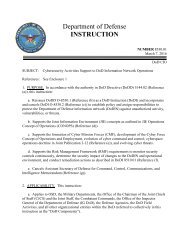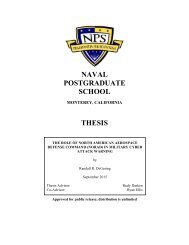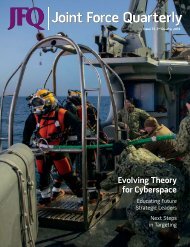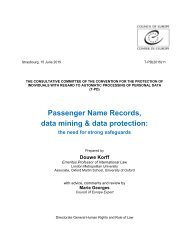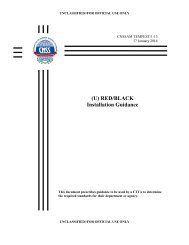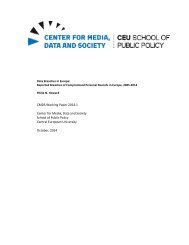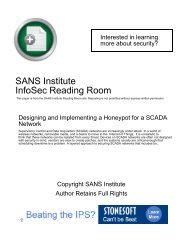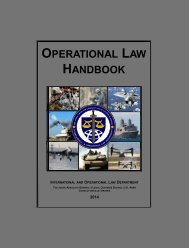SCHOOL THESIS
?view&did=768625
?view&did=768625
You also want an ePaper? Increase the reach of your titles
YUMPU automatically turns print PDFs into web optimized ePapers that Google loves.
Conclusion 4<br />
Executive Order 13589, Structural Reforms to Improve the Security of Classified<br />
Networks and the Responsible Sharing and Safeguarding of Classified Information, was<br />
issued in 2011; however, in January 2015, DOD reported its Insider Threat Detection<br />
Program estimated initial operating capability is not expected until January 2017 with no<br />
projection when full operating capability will occur. 391 This executive action is a direct<br />
result of the WikiLeaks disclosures. The executive order requires the federal government,<br />
under the co-chair of the director of national intelligence and the attorney general, to<br />
develop an insider threat program for:<br />
deterring, detecting, and mitigating insider threats, including the<br />
safeguarding of classified information from exploitation, compromise, or<br />
other unauthorized disclosure, taking into account risk levels, as well as<br />
the distinct needs, missions, and systems of individual agencies. This<br />
program shall include development of policies, objectives, and priorities<br />
for establishing and integrating security, counterintelligence, user audits<br />
and monitoring, and other safeguarding capabilities and practices within<br />
agencies. 392<br />
Recommendation 4<br />
DHS HQ must determine what assistance is required to develop an insider threat<br />
program to allow for earlier implementation. This will require direct coordination with<br />
the offices working this issue at the national level.<br />
Conclusion 5<br />
The current security clearance process is weak and needs to be revamped. As<br />
Sarbin, Carney, and Eoyang illustrate, there is no method that could identify current or<br />
future “spies” and differentiate them from innocent employees. They continue to say,<br />
“The issue becomes especially controversial when it comes to assessments of personal<br />
loyalty, patriotism and reliability.” 393 This certainly can be seen in the cases of Chelsea<br />
391 Steven Aftergood, “Insider Threat” Program Lags behind Schedule,” Federation of American<br />
Scientists, January 12, 2015, http://fas.org/blogs/secrecy/2015/01/insider-threat-lags/<br />
392 Exec. Order No. 13587, 76 Fed. Reg. 198 (October 13, 2011), §6.1<br />
393 Sarbin, Carney, and Eoyang, Citizen Espionage, 70.<br />
110



